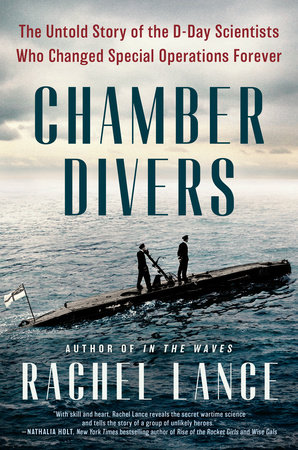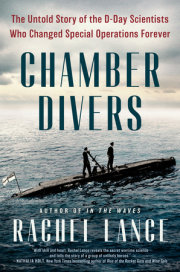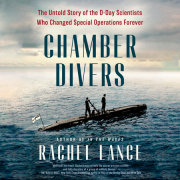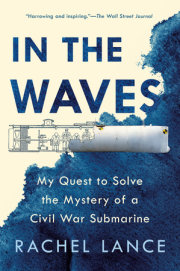CHAPTER 2
Brooklyn Bridge of Death
On February 28, 1872, two decades before J. B. S. Haldane’s birth, Brooklyn Bridge laborer Joseph Brown was submerged well below the murky waters of New York City’s East River. . . technically. The twenty-eight-year-old American-born foreman sloshed through a shallow layer of dark, frigid water in his work-issued, thigh-high black rubber Goodyear boots, but the rest of him stayed dry, free to hoist a pickax or a sledgehammer beneath the low ceiling and bring it down with enough force to remove yet another hunk from the rocky sand of the moist river floor.
Caissons are massive constructions that look a bit like large rectangular wooden bowls. They’re turned so the open mouth faces downward,and they get plunked into the water beneath a layer of hefty building material thick enough to ensure that they plummet firmly to the bottom. Once they have settled onto the topmost, waterlogged layer of unstable earth on the river floor, workers use gas pumps to push air down into them from the surface, and that compressed air blows out the water from inside the inverted bowls. The workers are then free to travel down into the wooden structures and dig inside, working the edges of the caisson downward inch by painful inch into the muck and soil as they remove bucketfuls of stone and earth from below. Each caisson used for the Brooklyn Bridge was thirty-one by fifty-two meters in size, divided into six long chambers by internal walls. They were sizable hunks of a city block beneath the waves, but with no sun, and with impenetrably thick, flat, iron-reinforced wooden skies looming only three meters overhead. Brown, like so many others, sloshed inside.
The dark, soggy, air-filled crawl spaces had floors of mud and sand and were peopled by “sand hogs”— workers wielding pickaxes, chisels, sledgehammers, and shovels. As the sand hogs dug, the knife-edge perimeter of the bowl crept downward, the crushing weight of the tower above held at bay almost exclusively by the upward push of the pressurized air within. More layers of stone were arranged carefully on top of each caisson as it sank, and these layers became the pillars of the bridge, creeping their way from the river floor downward to the bedrock like the probing roots of a massive stone tree. When the workers hit bedrock, they would evacuate, the empty space inside the caisson would be filledwith cement, and the entire monolith would be left in place as a support for the stable thoroughfare above.
The humidity of the river mingled with Joseph Brown’s sweat and the evaporated stench of the laboring crew around him. Most of the workers had long ago peeled off their shirts, or they had gone down without them in the first place. The air temperature around them rose to tropical levels with each swing of their tools, even as their feet froze from the chill water, and they could feel their headaches slowly build as they breathed and rebreathed the same air inside the enclosed space. Brown and the rest of the roughly sixty-person working crew were at the end of their third hour inside the humid, dimly lit, wooden-walled caisson. For foreman Brown, it was the end of his watch. It was hot. It was humid. It was time to come up. He headed for one of the ladders.
A particularly brutal winter in 1867 had iced the East River, the obstacle between Brooklyn and Manhattan, and left the ferryboats locked at their piers. After that difficult winter, the people of Brooklyn had decided they wanted a bridge to Manhattan. But not just any bridge. With the East River more of a broad, active tidal basin than a river, stretching an immodest five hundred meters across, it would need to be the longest suspension bridge in the world. So it would need burly supports on either end to keep it strong. And in order to let ships pass under the bridgefreely, each of those supports would need to be the tallest construction in America at that time—excepting a few stray church spires and the Statue of Freedom, which nudged the Capitol Building in Washington, DC, to a few feet of advantage.
To keep out the river, the air inside a caisson needs to be at least the same pressure as the water outside. So, as the depth of the roots increases, the pressure in the air increases, too. Joseph Brown’s caisson was on the deeper, Manhattan side of the bridge. Far beneath the river, just like inside a pressurized chamber, the compressed air was thick. Because of the increased density, voices rose in pitch. Here, again like in the chamber, it became impossible to whistle. And it became dangerous. On February 28, 1872, Joseph Brown had been unknowingly working just beyond the cusp of where that pressure could become a deadly problem.
Brown and his crew, exhausted, shirtless, sweaty, filthy, and covered in river mud, climbed up the rungs of the stubby ladder and into the lock embedded in the roof of their caisson. The lock was a sturdy chamber in the shape of an upright cylinder, and it could hold up to thirty workers when densely packed. Once the last worker clambered up through the hatch in the floor of the lock, they closed and secured it behind them.
Finally, after hours at work beneath the suffocating body of the East River, the workers could see the sky again through the small reinforced window inside the opposing hatch in the lock ceiling. Only after the gas space of the lock was depressurized to the same pressure as the air outside could that upper door swing open, but then the sand hogs would be able to climb up the winding spiral staircase to fresh air, hot coffee, and freedom.
First, a crew member turned on the heating mechanism, which would send scalding steam flowing through the metal coils attached to the interior walls of the lock, in anticipation of the humid, bone-penetrating sort of cold that fills any space containing rapidly expanding air. The coils began to warm. Then the lock operator slowly and ever so slightly cracked open the brass valve to vent the pressurized air. The hissing scream of traveling gas dominated while the pressure dropped. Steam condensed out of the very air itself, an eerie and frigid indoor fog. The lock approached the lower pressure level of the outside world. Then the trouble started for Joseph Brown.
At first he thought that he was fine. It took about ten minutes to vent enough gas to reach surface pressure, and after that, he climbed out of the lock and up the long, twisting route toward daylight. Little is known about what he did next, but perhaps he relaxed at the top, or drank a cup of hot broth offered to him by the on‑site doctor. Perhaps he jumped into a carriage to head straight home. But whatever choices he made, almost precisely one hour after leaving the caisson, a sudden stabbing bolt of agony rippled through Joseph Brown’s left shoulder and arm. Pain ran through his joints and along his nerves like lightning, “like the thrust of a knife.”
Nothing relieved the vicious pain, and nothing would. Not twisting his hand, not massaging the joint, not a “drachm” of ergot—a small dose of a medically unhelpful hallucinogenic fungus that grows on wheat—that he might have been prescribed by the bridge physician Andrew Smith. Brown simply lived with the hot, throbbing, jagged, penetrating neurological sensation of stabbing fire until the next afternoon, when he needed yet again to go down into the damp, murky depths in order to make a living.
Immediately when he reached the bottom of the river, the pain disappeared. His arm was healed; it worked as it should; he had no discomfort. He blissfully completed his shift, and he came back to the surface again, in the lock, slowly. This time, after the ascent, he had no issues.
The next day Joseph Brown’s arm still remained mostly pain-free, but it was covered with tiny red speckles. Freckles of blood had popped up like confetti on the parts of his arm and shoulder where yesterday’s pain had screamed the loudest. He reported to the bridge doctor Andrew Smith that those areas were slightly sore and slightly numb, and Dr. Smith was perplexed. Smith logged Brown’s strange symptoms in his notes. For months Smith would continue to wonder about their cause.
As the project progressed, the medical cases seen by Dr. Smith began to increase in tempo. More workers from each shift emerged from the caisson to become bent and contorted with often crippling pain. Each surfacing of the lock became the beginning of an ominous period of waiting for catastrophe to strike. Dr. Smith began recording everything obsessively, trying to understand, trying to treat, trying to figure out the pattern, trying—but failing—to save the workers from the mysterious ailment.
John Roland took a hit on March 8. While in a horse-drawn car and going home, he felt suddenly dizzy, lost all his strength, and could not stand. His feet were cold but his head was hot and he began sweating the disturbing, cold perspiration of an immune system fighting a demon. He recovered on his own within a few hours.
Hugh Rourke was next. On March 12, he, too, was going home when his right knee felt the telltale stabbing of knives deep inside the joint that left him suffering through the night. Rourke turned to morphine for relief. It became an addiction.
The deaths began in April, when the caisson roots stretched beyond sixty feet deep. German immigrant John Myers was the first on record. He dropped dead without warning after leaving a shift, having mentioned only that he was “feeling oppressed by the impurity of the air.” Patrick McKay collapsed the next day, unconscious, while walking down Roosevelt Street, having just left work. He was carted to a local hospital where he died in agony. His death was labeled “congestion of the brain” by perplexed physicians.
By May, a mere month before the pressurized work was done, when the caisson was nearing its deepest depths, the trickle of cases bloomed to a flood. On May 2, James Hefferner had pain, projectile vomiting, and extreme constipation. On May 4, Thomas Kirby had severe pain and swelling of the right arm. The sand hogs began to strike, demanding three dollars for every four hours of the dangerous work, instead of their previous rate of $2.43. On May 8, German immigrant Bruno Wieland was hit with pain, vomiting, loss of bladder control, temporary paralysis, and inability to stand or walk. They got their wage increase.
Then Dr. Smith wrote one medical case report that would provide more information and more useful clues than all the others. Yet ironically he did not list the victim’s full name. He wrote: “Reardon, England, 38.” His report is simple but brutal: “Began work on the morning of May 17; was advised to work only one watch the first day, but nevertheless, feeling perfectly well after the first watch, went down again in the afternoon.” Determined to work a second shift, Mr. Reardon refused to give his body the acclimation and trial period the doctors recommended. He refused to wait to see how his body responded to its first day of pressure. And so, after a morning of 2.5 hours hacking away at the river bottom, seventy-eight feet beneath the water, the stubborn Mr. Daniel Reardon, his full name known only through his death certificate, ate his lunch and climbed back into the shaft for a second shift.
It was his undoing. Immediately after his second depressurization, Reardon “was taken with very severe pain in the stomach, followed by vomiting,” and that pain quickly escalated. It spread to his legs. Within minutes, he was paralyzed from the waist down, but still feeling the agonizing fire. Unable to move his limbs, he could feel rivulets of pain coursing through them, excruciating stabbing needles from the wrath of increased pressure released too quickly. It could not be controlled by morphine. Daniel Reardon died the next day after having vomited through the night, having felt no release from the chronic lightning bolts of agony that made him twist and bend his body into strange and terrifying shapes.
Reardon, unlike the others, had an autopsy. When the doctors cut him open, they saw that his lungs were engorged, filled with the fluid and phlegm produced by a body struggling for breath. His spinal cord was “intensely congested,” meaning that it showed a telltale eruption of blood just above the nerves that, in life, should have controlled the movement of his legs.
Still, he was not the last. By June the newspapers were reporting the deaths with an air of fatigue. On June 18, laborer James Reilly’s paralysis and critical medical state were announced under the worn-out‑sounding headline “The Caisson Again.”
The average sand hog on the Brooklyn Bridge lasted only three weeks on the job. Most wandered off without notice, either too hurt or too scared to continue. Although they were referring to other construction accidents, too, the newspapers called it “the Bridge of Death.”
Copyright © 2024 by Rachel Lance. All rights reserved. No part of this excerpt may be reproduced or reprinted without permission in writing from the publisher.







